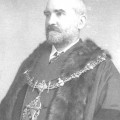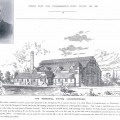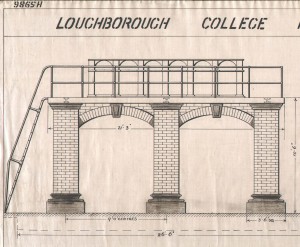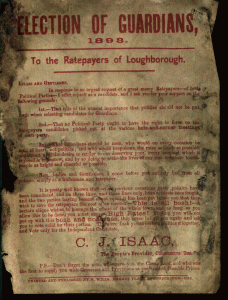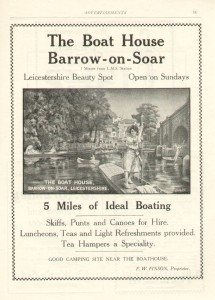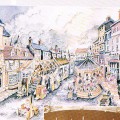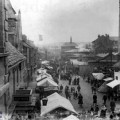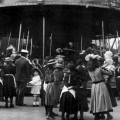Alderman Joseph Griggs, First Mayor of Loughborough
20 March 2015
- Alderman Joseph Griggs
- An article about the Baths in the Loughborough Echo of 1898.
Alderman Joseph Griggs, J.P., D.L., became first mayor of Loughborough in November 1888. Loughborough became a municipal borough in 1888 and thus, for the first time, had an efficient system of government. Alderman Griggs was noted for his public spirit and the Loughborough Herald of 1889 states that ‘his popularity is equally as great with the toilers as it is with the gentry’.
‘Mountfields’ on Forest Road was built for him in 1878 and in his day, became famous for its garden parties, to which ‘the worthy burgesses and county friends of the town’ were invited. Alderman Griggs most enduring monument was his donation of the Queen’s Memorial Baths (now Charnwood Museum) in Granby Street which cost £4000 to build and which he presented to the town in 1898.
The Watt Beam Engine
17 March 2015
One of Loughborough University’s landmarks is the Watt beam engine which stands in its smart red and green livery near the Students’ Union. The engine was presented to Loughborough College, the forerunner of the University, by the Metropolitan Water Board in 1934.
The first successful steam engine had been built by Thomas Newcomen in 1712 to pump water out of the mines. James Watt improved on Newcomen’s design in 1769 by condensing steam outside the cylinder and using it to move the piston, and in 1782 he introduced his first double-acting engine. Watt continued to develop improvements for the steam engine including the separate condenser, the air pump, the indicator, the pendulum governor and the parallel motion. Steam engines came to be used extensively for providing power and were the only means used for this purpose until the end of the nineteenth century.
The beam engine at Loughborough was built by James Watt & Co, Soho, and supplied to the South London Water Works in Belvedere Road in 1850. Later it was moved to the Thames Ditton Works of the Lambeth Water Company for draining filter beds and remained in service at Surbiton until 1933. The Metropolitan Water Board was commended by the journal Engineering for saving the historic engine by donating it to Loughborough College and not consigning it to the scrap heap after its useful life was over.
The boiler of the Watt engine arrived at the College, pulled by five horses, in May 1934 and its re-erection was supervised by James Driver, Head of the Department of Electrical Engineering and Manager of the College Workshops. Driver described the engine in detail in an article in the College magazine The Limit, commenting on the excellence of the workmanship, especially that which had been done by hand and not machined. The supporting structure was designed and made at the College and the drawings for the foundations remain in the University Archives.
Jenny Clark, Loughborough University Archives
“This is all Bosh!” 1893 Election Poster
13 March 2015
Loughborough resident Adrian Bailey was renovating his home in Fearon Street a few years ago when he found an election leaflet from 1893. It was printed by H Wills of Market Place, for C J Isaac, ‘the People’s Provider’ of the Consumers Tea Company. It is addressed to the ‘Ratepayers of Loughborough’ and asks for support in the election of guardians to the Union Workhouse in Regent Street.
Mr Isaac offers himself for election on the grounds that he is the ‘only independent candidate’. Standing ‘simply as a Tradesman and a Ratepayer’, he dismisses the claims of the two main parties (Conservative and Liberal) that they wish to avoid the costs of an election as ‘bosh and nonsense’. He also reminds readers that he supplies ‘the Cheap Loaf’ and ‘Groceries and Provisions at the Lowest Possible Prices’.
Adrian believes that the Consumers Tea Company stood on the corner of the Swan Street and Biggin Street, where a slot machine casino now stands. The original building was probably demolished when the High Street was widened in the 1920s.
The Loughborough Union Workhouse was a large and important building set in extensive grounds to the south of Derby Road.
According to the informative website of Peter Higginbotham, the Loughborough Poor Law Union officially came into existence in 1838 and was overseen by an elected board of twenty-eight ‘guardians’ representing twenty-four parishes across North Leicestershire and South Nottinghamshire. The original structure accommodated 350 inmates and was built in 1838 at a cost of £6,550. It was extended in 1874 at a cost of £535. The Union Workhouse became a Public Assistance Institution in the 1930s and was renamed Hastings House, and later Regent Hospital, which continued as an old people’s home and hospital until its closure in the late 1980s. The building was then demolished.
Please contact us if you have any memories, pictures, or family stories about the workhouse or the old peoples’ home that it became.
Click here to find a list of inmates of the 1881 Loughborough Workhouse.
Advertising in ‘The Limit’ – the Loughborough College Magazine
10 March 2015
Loughborough College magazine, The Limit, was first published in 1918 and printed by The Echo Press in Loughborough. It aimed to be entertaining, instructive and stimulating and to bring together the different sections of the College. It contained a mix of serious and humorous articles; reports of College sports events, plays, and club activities; poems, cartoons and photographs; and news of former students. It also carried advertisements for College products and services and for both national and local businesses.
This issue of The Limit, for April 1925, includes advertisements aimed at students for scientific instruments, stationery, books, sports equipment, trophies, and clothing from companies across the land. Locally, there were advertisements from the engineering firm of Herbert Morris Ltd and many other local businesses. There was Hyde Bain, Ophthalmic Opticians, in the High Street; Chas. W Tyler, Ironmonger and Seedsman (‘Wireless a Speciality’), in Derby Square; W Bramley, Greengrocer, at Ward’s End; Marsden’s the Grocers and Bolesworth’s Dairy & Tea Rooms, in the Market Place; JW Barker’s ‘Midland Hygienic Bakery’ in Mill Street; the Loughborough & Charnwood Forest Coal Co. Ltd of Baxter Gate; JT Bailey, the Butcher (‘your patronage is respectfully solicited’) and Paltridge’s Pianos (‘unrivalled for purity of tone, reliability, workmanship and intrinsic value’) on opposite sides of Church Gate; and H Lacey, (‘the best house in Loughborough for pork pies, sausages and polonies’) in Ashby Square.
Perhaps the most attractive local advertisement in this issue of The Limit is the one for Barrow-on Soar boathouse, which might conjure up an Oxbridge-like vision of flannelled students, languidly propelling young ladies in punts – though the Loughborough young lady pictured here is making a pretty good job of punting herself!
Jenny Clark, Loughborough University Archives
Loughborough Town Fair
3 March 2015
- The Market Place in the early 1800s . Illustration taken from ‘The Making of Loughborough’ by Don Wix, Wallace Humphrey and Ian Kiel
- Loughborough Fair circa 1894
- Loughborough Fair circa 1890s
The majority of fairs in Britain trace their history back to the medieval period and beyond, and Loughborough’s fair is no exception. Markets and fairs as centres of trade, commerce and entertainment have been held in Loughborough for well over 700 years.
The original Charter was granted to Loughborough in 1221 for an annual fair held on the 31st of July. Seven years later this was extended to include three days around the Feast of St Peter on the 29th June, with a third Charter for a fair on the Feast of All Souls in November granted to Hugh le Despencer, Lord of the Manor of Loughborough, in 1228. The Charter enabled the Lord of the Manor to organise and regulate the fair in return for revenue collected from stall holders.
November hiring fairs, also known as statue or ‘mop fairs’, can be traced to 1351 when Edward III passed legislation to regulate a labour force reduced to low levels by the plague. Traditionally, male and female workers attended these fairs to offer their services to employers for the coming year. The November fair in Loughborough came into existence for just such a purpose and continued until the end of the 19th century.
Around a hundred show people bring their rides, amusements and refreshment stalls to Loughborough Fair each year, which falls at the end of their travelling calendar. Families such as the Collins, the Proctors and the Hollands have been part of the travelling community for generations and many remain in the area over the winter period.
Detailed information on the history of fairs, including the annual fair in Loughborough, can be found on Sheffield University’s National Fairground Archive. The site includes photographs taken of Loughborough Fair during the late 1950s and early 1960s.
Additional information for this feature was sourced from the Charnwood Borough Council website.
You can watch a video walk-through of Loughborough Fair recorded in November 2013.
New book on Fowke Street, Rothley is published
1 March 2015
Fowke Street, Rothley by Terry Shepherd is a new 216 page history of this special village street.
The book discusses where Fowke Street got its name and traces the 240 year story of The Grange, the big house around which Fowke Street bends. It features the Industrial Co-operative Society which prospered and then had to be rescued, the 13th century cruck cottage which survived into the third millennium, the school which was created, enlarged and, in 2004, transformed into community rooms, and the story of the long-serving vicar who raised a fortune in 1877 to restore and reformat the medieval parish church.
Readers will learn about the farmyard, some cottages and a field which became a knitwear factory and then modern business units, as well as the ‘big house’ built over the site of an extensive Saxon cemetery and which has now been developed into apartments.
‘Fowke Street, Rothley’ costs £15 and is available from Terry Sheppard by email at sheppard7pj@btinternet.com or telephone on 0116 230 2931.
